4.3: Balance My Energy
- Page ID
- 2388
\( \newcommand{\vecs}[1]{\overset { \scriptstyle \rightharpoonup} {\mathbf{#1}} } \)
\( \newcommand{\vecd}[1]{\overset{-\!-\!\rightharpoonup}{\vphantom{a}\smash {#1}}} \)
\( \newcommand{\id}{\mathrm{id}}\) \( \newcommand{\Span}{\mathrm{span}}\)
( \newcommand{\kernel}{\mathrm{null}\,}\) \( \newcommand{\range}{\mathrm{range}\,}\)
\( \newcommand{\RealPart}{\mathrm{Re}}\) \( \newcommand{\ImaginaryPart}{\mathrm{Im}}\)
\( \newcommand{\Argument}{\mathrm{Arg}}\) \( \newcommand{\norm}[1]{\| #1 \|}\)
\( \newcommand{\inner}[2]{\langle #1, #2 \rangle}\)
\( \newcommand{\Span}{\mathrm{span}}\)
\( \newcommand{\id}{\mathrm{id}}\)
\( \newcommand{\Span}{\mathrm{span}}\)
\( \newcommand{\kernel}{\mathrm{null}\,}\)
\( \newcommand{\range}{\mathrm{range}\,}\)
\( \newcommand{\RealPart}{\mathrm{Re}}\)
\( \newcommand{\ImaginaryPart}{\mathrm{Im}}\)
\( \newcommand{\Argument}{\mathrm{Arg}}\)
\( \newcommand{\norm}[1]{\| #1 \|}\)
\( \newcommand{\inner}[2]{\langle #1, #2 \rangle}\)
\( \newcommand{\Span}{\mathrm{span}}\) \( \newcommand{\AA}{\unicode[.8,0]{x212B}}\)
\( \newcommand{\vectorA}[1]{\vec{#1}} % arrow\)
\( \newcommand{\vectorAt}[1]{\vec{\text{#1}}} % arrow\)
\( \newcommand{\vectorB}[1]{\overset { \scriptstyle \rightharpoonup} {\mathbf{#1}} } \)
\( \newcommand{\vectorC}[1]{\textbf{#1}} \)
\( \newcommand{\vectorD}[1]{\overrightarrow{#1}} \)
\( \newcommand{\vectorDt}[1]{\overrightarrow{\text{#1}}} \)
\( \newcommand{\vectE}[1]{\overset{-\!-\!\rightharpoonup}{\vphantom{a}\smash{\mathbf {#1}}}} \)
\( \newcommand{\vecs}[1]{\overset { \scriptstyle \rightharpoonup} {\mathbf{#1}} } \)
\( \newcommand{\vecd}[1]{\overset{-\!-\!\rightharpoonup}{\vphantom{a}\smash {#1}}} \)
\(\newcommand{\avec}{\mathbf a}\) \(\newcommand{\bvec}{\mathbf b}\) \(\newcommand{\cvec}{\mathbf c}\) \(\newcommand{\dvec}{\mathbf d}\) \(\newcommand{\dtil}{\widetilde{\mathbf d}}\) \(\newcommand{\evec}{\mathbf e}\) \(\newcommand{\fvec}{\mathbf f}\) \(\newcommand{\nvec}{\mathbf n}\) \(\newcommand{\pvec}{\mathbf p}\) \(\newcommand{\qvec}{\mathbf q}\) \(\newcommand{\svec}{\mathbf s}\) \(\newcommand{\tvec}{\mathbf t}\) \(\newcommand{\uvec}{\mathbf u}\) \(\newcommand{\vvec}{\mathbf v}\) \(\newcommand{\wvec}{\mathbf w}\) \(\newcommand{\xvec}{\mathbf x}\) \(\newcommand{\yvec}{\mathbf y}\) \(\newcommand{\zvec}{\mathbf z}\) \(\newcommand{\rvec}{\mathbf r}\) \(\newcommand{\mvec}{\mathbf m}\) \(\newcommand{\zerovec}{\mathbf 0}\) \(\newcommand{\onevec}{\mathbf 1}\) \(\newcommand{\real}{\mathbb R}\) \(\newcommand{\twovec}[2]{\left[\begin{array}{r}#1 \\ #2 \end{array}\right]}\) \(\newcommand{\ctwovec}[2]{\left[\begin{array}{c}#1 \\ #2 \end{array}\right]}\) \(\newcommand{\threevec}[3]{\left[\begin{array}{r}#1 \\ #2 \\ #3 \end{array}\right]}\) \(\newcommand{\cthreevec}[3]{\left[\begin{array}{c}#1 \\ #2 \\ #3 \end{array}\right]}\) \(\newcommand{\fourvec}[4]{\left[\begin{array}{r}#1 \\ #2 \\ #3 \\ #4 \end{array}\right]}\) \(\newcommand{\cfourvec}[4]{\left[\begin{array}{c}#1 \\ #2 \\ #3 \\ #4 \end{array}\right]}\) \(\newcommand{\fivevec}[5]{\left[\begin{array}{r}#1 \\ #2 \\ #3 \\ #4 \\ #5 \\ \end{array}\right]}\) \(\newcommand{\cfivevec}[5]{\left[\begin{array}{c}#1 \\ #2 \\ #3 \\ #4 \\ #5 \\ \end{array}\right]}\) \(\newcommand{\mattwo}[4]{\left[\begin{array}{rr}#1 \amp #2 \\ #3 \amp #4 \\ \end{array}\right]}\) \(\newcommand{\laspan}[1]{\text{Span}\{#1\}}\) \(\newcommand{\bcal}{\cal B}\) \(\newcommand{\ccal}{\cal C}\) \(\newcommand{\scal}{\cal S}\) \(\newcommand{\wcal}{\cal W}\) \(\newcommand{\ecal}{\cal E}\) \(\newcommand{\coords}[2]{\left\{#1\right\}_{#2}}\) \(\newcommand{\gray}[1]{\color{gray}{#1}}\) \(\newcommand{\lgray}[1]{\color{lightgray}{#1}}\) \(\newcommand{\rank}{\operatorname{rank}}\) \(\newcommand{\row}{\text{Row}}\) \(\newcommand{\col}{\text{Col}}\) \(\renewcommand{\row}{\text{Row}}\) \(\newcommand{\nul}{\text{Nul}}\) \(\newcommand{\var}{\text{Var}}\) \(\newcommand{\corr}{\text{corr}}\) \(\newcommand{\len}[1]{\left|#1\right|}\) \(\newcommand{\bbar}{\overline{\bvec}}\) \(\newcommand{\bhat}{\widehat{\bvec}}\) \(\newcommand{\bperp}{\bvec^\perp}\) \(\newcommand{\xhat}{\widehat{\xvec}}\) \(\newcommand{\vhat}{\widehat{\vvec}}\) \(\newcommand{\uhat}{\widehat{\uvec}}\) \(\newcommand{\what}{\widehat{\wvec}}\) \(\newcommand{\Sighat}{\widehat{\Sigma}}\) \(\newcommand{\lt}{<}\) \(\newcommand{\gt}{>}\) \(\newcommand{\amp}{&}\) \(\definecolor{fillinmathshade}{gray}{0.9}\)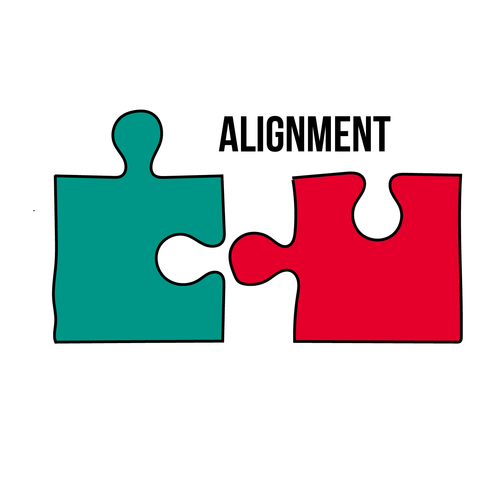
National Health Education Standards [NHES]
- 1.12.1 Predict how healthy behaviors, such as daily physical activity, affects health status.
- 7.12.2 Demonstrate a variety of healthy practices and behaviors, such as balancing calorie intake with exercise, that will maintain or improve the health of self and others.
Wellness Guidelines
- Increase the frequency of physical activity

- Instruction:
- In a group or think pair share format, have participants discuss the following questions. Acknowledge those who have progressed toward their goal(s) and encourage anyone who wants to change or modify their goal to get 1:1 support.
- Share: Let’s discuss our SMART Goals.
- How is it going with your current SMART goal?
- What are some ways you can improve progress toward your goal? (Grows)
- What are some ways you are doing well with progress towards your goal? (Glows)
GUIDELINE: Increase Frequency of Physical Activity
- Share: What guideline do you think is related to today’s lesson? Who has a SMART Goal related to this guideline?
- Instruction: Select one activity.
- Guideline Popcorn: The group lists all 8 guidelines rapidly in popcorn format.
- Guideline Charades: Divide participants into groups and assign each a guideline. Each group has to silently act out the guideline for the rest to guess.
- Two Truths and One Lie:
- Truth 1: Exercise can affect how well you sleep.
- Truth 2: Exercise can affect how well you will perform in school.
- Lie: Physical inactivity can’t make you sick.
- Share: Physical inactivity can prevent chronic illnesses like diabetes, obesity, high blood pressure, etc. [CDC, 2009].
- Questions to discuss and/or journal:
- How often do you usually exercise? Where do you usually exercise? What exercise do you usually do?
- What do you like about exercise?
- What do you dislike about exercise?
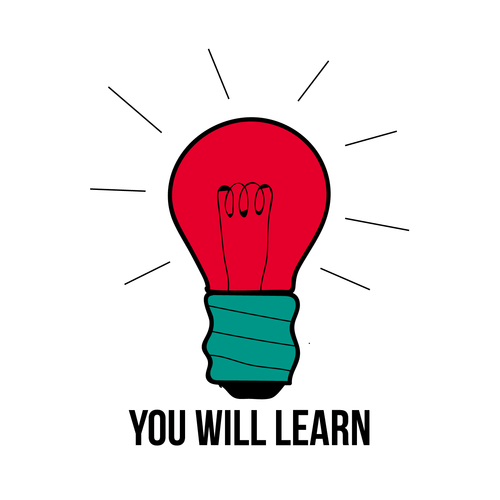
- How having healthy habits keeps your body functioning efficiently.
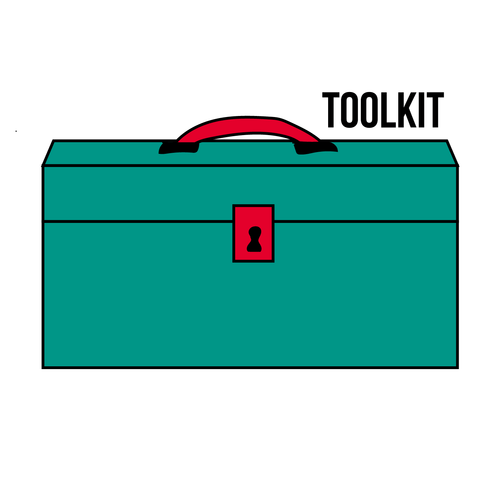
- Worksheets
- Slide presentation
- Sticky notes with key terms on them
- Definitions of key terms printed on separate pieces of paper
- Tape/push-pins
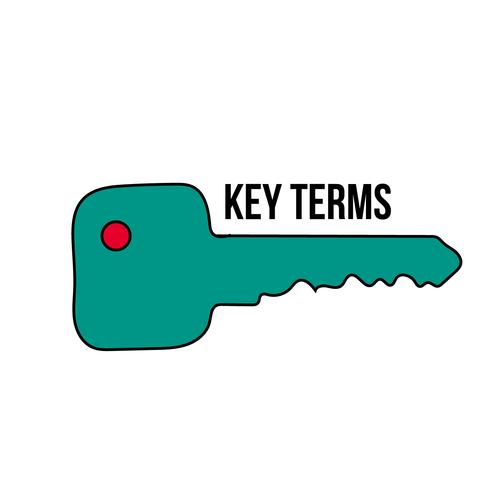
[As defined by: HHS, 2008; USDA & HHS, 2015.]
- Calorie: A unit commonly used to measure the energy content of foods and beverages as well as energy use by the body.
- Input: Something (such as power or energy) that is put into a system.
- Output: Something (such as power, energy, or information) that is produced by a system.
- Physical Activity: movement that is carried out by the skeletal muscles that require In other words, any movement one does is actually physical activity.
- Exercise: Movement of the body that uses energy that is planned, structured, repetitive, and purposive.
- Habit: Something that a person does often in a regular and repeated way.
- Intensity: How much work (force, weight, or the magnitude of the effort) is required to perform an activity or exercise.
- Metabolism: The chemical processes by which a plant or an animal uses food, water, etc., to grow and heal and to make energy.
- Basal Metabolic Rate: The rate of energy usage over a period of time by humans/animals at rest.
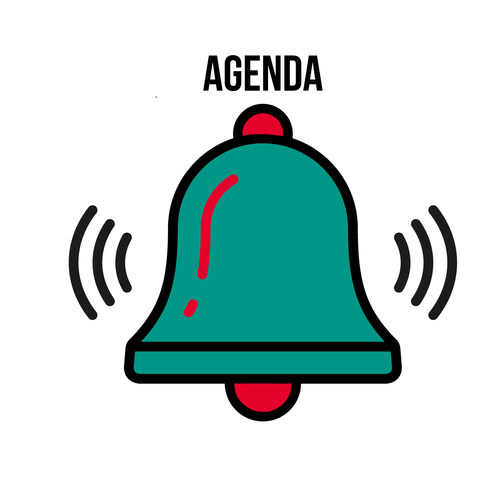
- Do Now
- Balancing Basics
- Fact or Fiction
- Match It Up Relay
- Exit Ticket
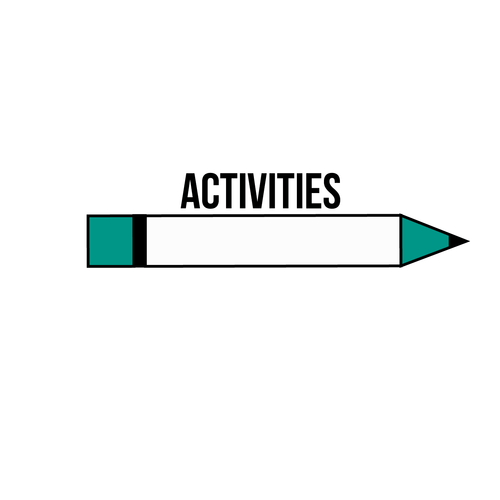
Do Now:
- Instruction:
- Have participants answer the following questions on their worksheet or by sharing out loud.
- How often do you exercise and for how long?
- What keeps you from exercising every day?
- Lack of time
- Lack of gym membership/equipment (too expensive)
- Lack of motivation (find it boring)
- Too difficult
- Are calories bad? Why or why not?
- Calories in and of themselves are not bad or good.
- Have participants answer the following questions on their worksheet or by sharing out loud.
- Share:
- A calorie is a unit commonly used to measure the energy content of foods and beverages as well as energy use by the body.
- Calories are very important because we need them to sustain bodily functions such as moving, breathing, and sleeping [USDA & HHS, 2015].
- Today, we’ll be looking at calorie input and output in terms of weight management.
- Input is something (such as power or energy) that is put into a system while the output is something that is produced by a system. In this case, the “system” we’ll be focusing on is your body!
Good to Know: Balancing Basics
- Share:
- How would someone go about maintaining their healthiest weight?
- They would try to balance the input and output of energy or calories over time [NIH, n.d.].
- An example of an input is the food you eat, while an example of an output is exercise.
- What if you would like to lose weight or gain weight?
- What do you think you would need to do?
- Energy is another word for "calories." Your energy balance is the balance of calories consumed through eating and drinking compared to calories burned through physical activity. What you eat and drink is ENERGY IN. What you burn through physical activity is ENERGY OUT [NIH, n.d].
- To lose weight would mean that energy output needs to be greater than energy input.
- Meanwhile, to gain weight would mean that energy input is greater than energy output.
- Share:
- How much you weigh and whether you gain or lose weight are also influenced by things inside and outside your body, such as your genetics and environment. Some things you have control over, and there are a lot of things you don't have control over.
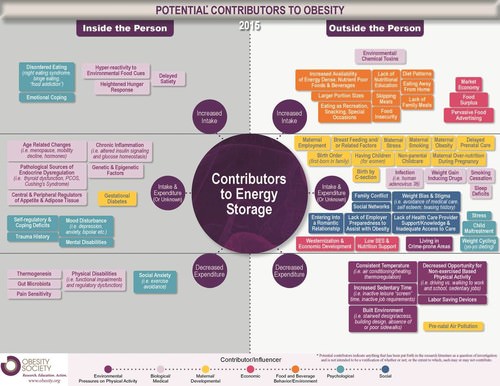 Image From: www.obesity.org/obesity/resou...ors-to-obesity
Image From: www.obesity.org/obesity/resou...ors-to-obesity- However, there are some things that are within your control like diet and exercise. As mentioned earlier, physical activity is a great way to output energy or burn calories. Exercise is a movement of the body that uses energy that is planned, structured, repetitive, and purposive.
- Besides helping with weight management, other benefits of regularly exercising include preventing certain illnesses (such as heart disease), boosting your energy, promoting better sleep, strengthening your muscles and bones, releasing endorphins, which help you feel happy and improve mood, boosting your brain power by helping your memory and focus, and strengthening your immune system [CDC, 2009].
- Did you know that it is recommended that adults get two (2) hours and thirty minutes of moderate-intensity physical activity, like brisk walking or bicycling, every week? And that children and adolescents should get one (1) hour of physical activity every day?
- Intensity is how much work (force, weight, or the magnitude of the effort) is required to perform an activity or exercise [HHS, 2008].
- That’s why it’s a great idea to make physical activity regularly into a healthy habit! A habit is something that a person does often in a regular and repeated way.
- Here are a few tips for making exercise a habit [CDC, 2017]:
- Preparation: When you plan ahead, being active is much easier for example, just like making lunch the night before school or work you can put your workout clothes and shoes out the night before. Then take the route to school or work or on your way home that goes past the gym. Add exercise breaks to your calendar just like lunch.
- Goal-setting: Make a SMART Goal! The more specific your goal is better, such as such as walking a mile every day for a month or being active every weekday for 15 minutes.
- Enjoy It: Choose something you like to do.
- Make Exercise Social: Work out with a partner. When someone else is counting on you to show up, you’ll likely hit the trail or the treadmill more regularly.
Real World Relevance: Fact or Fiction
- Share:
- Did you know that our bodies are always using energy, even when you don’t think you’re doing anything at all? However, we burn calories at different rates depending on factors, such as the activity level, age, height, weight, and gender. In other words, people have different metabolic rates.
- Metabolism is the chemical processes by which a plant or an animal uses food, water, etc., to grow and heal and to make energy.
- The basal metabolic rate (BMR) is the rate of energy usage over a period of time by humans/animals at rest. In other words, this is how many calories you would burn even in you just stayed in bed all day, taking into account your age, height, weight, and age.
- There are also a lot of myths and misconceptions about eating and exercise. Let’s address some today while getting some exercise!
- Instruction:
- Read the following statements aloud.
- For each statement, have participants who agree with the statement to move to the right side of the room and those who don't agree to move to the left side of the room. Then share the answer.
|
Statement |
Answer |
|
Carbs make you fat. |
Fiction: Too many calories make you fat. Carbohydrates are actually the body’s preferred choice of energy, especially for the brain. Everyone needs a good mix of carbohydrates, protein, and fat. Each one is essential for the body to function well. Too much of any of them (fat, protein, or carbs) may cause a weight gain due to excessive calorie intake. A low carb diet is nutritionally unbalanced and can cause lots of problems (i.e. lack of energy.) |
|
All types of chocolate are bad for you. |
Fiction: 70% dark chocolate has nutrients (antioxidants) that that keep your body healthy. But be sure to moderate your chocolate intake since everything is about balance. We can overdo a good thing. Although it is a great antioxidant, chocolate still contains added sugar, saturated fats and is high in calories. |
|
Eating some snacks in between meals can help you achieve and maintain a healthy weight. |
Fact: Your body needs food and nutrients throughout the day – it’s your fuel! When more than four hours go by between meals, your body’s energy supply dips and fatigue starts to set in. So snacking can help combat that! Eating throughout the day keeps your body from going into starvation mode. Snacks keep your body moving and working so that you have the energy to stay alert and awake. Snacking also prevents overeating. For example, eating a vegetable or fruit snack or a few almonds or walnuts during the day can help keep you full. Just remember nuts are high in calories. So be careful to avoid over-eating them as a snack! |
|
Fruit drinks are healthier and have fewer calories than sugary soda pop. |
Fiction: A 12-ounce can of sugary soda has 140 calories while a 12-ounce can of fruit punch has 180 calories. Both choices are loaded with sugar. Consider choosing water instead! It’s calorie-free and your body needs it! |
|
The less you eat, the more weight you’ll lose.
|
Fiction: If you don’t eat, you store what you consume instead of burning it when your body gets food again. |
|
Skipping meals is not a good way to lose weight. |
Fact: Studies show that people who skip breakfast and eat fewer times during the day tend to be heavier than people who eat a healthy breakfast and four or five times a day. People who skip meals tend to feel hungrier later on and eat more than they normally would. It may also be that eating many small meals throughout the day helps people control their appetites. |
|
Fat is bad for you. A no-fat diet is the best of all. |
Fiction: Fats are absolutely essential for the body to function normally and well. A moderate amount of fat will keep the cells intact, help regulate blood pressure, and keep hormones functioning properly. There are lots of different types of fat, and some are better than others. Some healthier sources of fats include olive oil, avocado, nuts. |
|
Fad diets aren’t always meant to help you lose weight and be healthy.
|
Fact: Different fad diets are created to make money (40-50 billion dollars annually to be exact). If the concept of dieting actually worked, they would cease to exist. Fad diets are often about restriction and about fighting against your body’s biology, but we should focus more on making sure our body is getting enough (but not too much) of the nutrients it needs. |
|
When it comes to health, your waist size can matter more than your total weight. |
Fact: Your waist size may be more important for your overall health than your weight. The upper limit is 40 inches for men and 37 inches for women. Fat elsewhere on your body is not as dangerous. Waist fat is particularly dangerous because it can compromise your organ functions and increase stress on those organs. |
Source:
- U.S. Department of Agriculture & U.S Department of Health and Human Services. (2015). Dietary Guidelines for Americans. Retrieved From: https://health.gov/dietaryguidelines/2015/resources/2015-2020_Dietary_Guidelines.pdf
Hands-On: Match It Up Relay
- Set Up:
- In different parts of the room, hang the definitions to the key terms for this lesson.
- Instruction:
- Divide the participants into teams, with a maximum of ten (10) members per team.
- Distribute ten (10) sticky notes with the ten (10) key terms to each team. To differentiate between different team’s sticky notes, have each team decide on a shape (star, square, etc.) and then draw it on all of their notes.
- Give the teams two (2) minutes to discuss possible definitions of the keywords. Once the two (2) minutes are up, have each team line up at the front of the class.
- Each team member should have two (2) sticky notes, each with a key term.
- Note: If there are less than five (5) team members, have the team decide which member(s) will have an extra sticky note.
- Optional: To differentiate between each team’s sticky notes, you can also give each team a different color sticky note (Team A gets blue notes, Team B gets yellow, etc.).
- Instruction:
- Once the relay starts, each team member must find the definitions that match their key terms and post up their sticky notes there.
- After a member has posted their sticky note, they can “tag” (tap on the shoulder, high-five, etc.) the next member of the team to allow them to start.
- The first team to have all of its members correctly post up their sticky notes wins.
- Instruct teams to do an exercise (jumping jacks, toe-touching stretches, etc.) to signal when they’re done.
- Note: Instruct participants not to run in order to avoid injury.
- Instruction:
- Review any key terms that were confusing for participants.
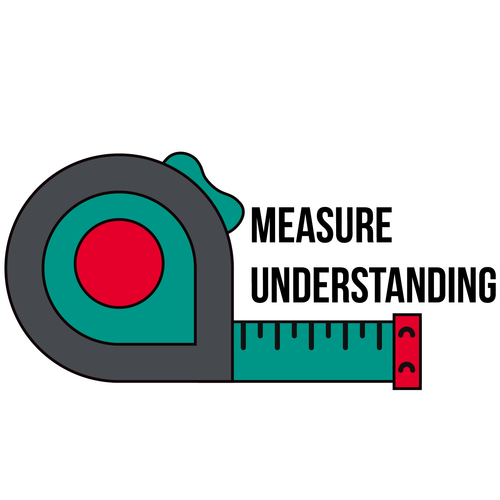
Exit Ticket:
- Instruction:
- Have participants write on their worksheet or share out loud the following question(s).
- How might balancing calorie intake with exercise to maintain or improve your health?
- Prevent certain illnesses (such as heart disease)
- Boost energy
- Promote better sleep
- Strengthen muscles and bones
- Improve mood
- Boost concentration and memory
- Strengthen immune system [CDC, 2015]
- How can you make regular exercise a habit?
- Plan ahead and schedule in your exercise
- Put your workout clothes and shoes out the night before
- Work out with a friend
- Make a SMART goal to exercise (such as walking a mile every day for a month)
- Choose an exercise you like to do [CDC, 2017]
- How might balancing calorie intake with exercise to maintain or improve your health?
- Have participants write on their worksheet or share out loud the following question(s).
Bibliography
- Centers for Disease Control and Prevention. (2017) Make Your Workout Work for You. Retrieved From: https://www.cdc.gov/features/diabete...ity/index.html
- Centers for Disease Control and Prevention. (2009). Physical activity. Retrieved From: https://www.cdc.gov/healthyplaces/healthtopics/physactivity.htm
- Centers for Disease Control and Prevention. (2015). Physical activity and health. Retrieved From: https://www.cdc.gov/physicalactivity...x.htm#benefits
- McNab BK. (1997). On the Utility of Uniformity in the Definition of Basal Rate of Metabolism. Physiological Zoology 70(6): 718–720.
- Merriam-Webster Learner’s Dictionary. (n.d.). Habit. Retrieved From: http://www.learnersdictionary.com/definition/habit
- Merriam-Webster Learner’s Dictionary. (n.d.). Rate. Retrieved From: http://www.learnersdictionary.com/definition/rate
- Merriam-Webster Learner’s Dictionary. (n.d.). Metabolism. Retrieved From: http://www.learnersdictionary.com/de...ion/metabolism
- Merriam-Webster Learner’s Dictionary. (n.d.). Output. Retrieved From: http://www.learnersdictionary.com/definition/output
- Merriam-Webster Learner’s Dictionary. (n.d.). Input. Retrieved From: http://www.learnersdictionary.com/definition/input
- National Heart, Lung, and Blood Institute. (n.d.). Aim for a healthy weight. Retrieved From: https://www.nhlbi.nih.gov/health/edu...e_wt/index.htm
- National Institute of Health. (n.d.). Balance Food and Activity. Retrieved From: https://www.nhlbi.nih.gov/health/edu...cs/balance.htm
- U.S. Department of Health and Human Services. (2008). 2008 Physical Activity Guidelines for Americans. Retrieved From: https://health.gov/paguidelines/pdf/paguide.pdf
- U.S. Department of Agriculture & U.S Department of Health and Human Services. (2015). Dietary Guidelines for Americans. Retrieved From: https://health.gov/dietaryguidelines...Guidelines.pdf

- The Obesity Society. (2015). Contributors to Energy Storage. Retrieved From: www.obesity.org/obesity/resources/facts-about-obesity/infographics/potential-contributors-to-obesity
This lesson was created in partnership with Albert Einstein College of Medicine Department of Epidemiology and Population Health with funding support by the National Institutes of Health NIDDK Grant R01DK097096.

